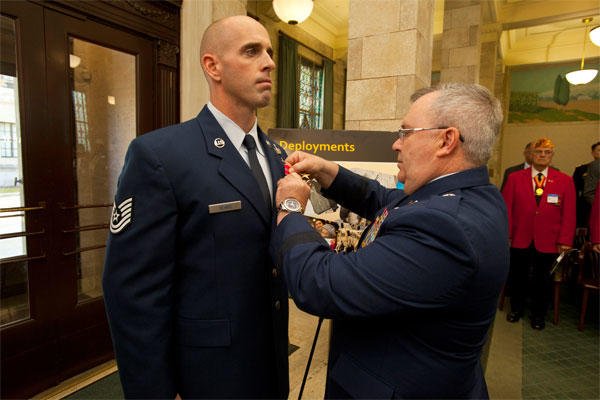TRENTON, N.J. -- When an explosive ordnance disposal team rolls out for a combat patrol, their objective is to defuse bombs and gather intelligence about the bomb-makers. It's not to engage the enemy. But as New Jersey Air National Guard Tech. Sgt. Mike Sears put it, sometimes, there's no choice. Sept. 29, 2012 was one of those days.
A three-man Air Force EOD team led by Sears found itself in the middle of a complex ambush on a dusty road in Ghazni Province, Afghanistan. Over the course of a two-hour firefight, Sears provided life-saving aid to a fallen coalition soldier from Poland; ran five times through a 150-yard open area riddled with enemy machine gun fire to direct his team in returning fire; and continued on with the fight even after being knocked temporarily unconscious by a rocket-propelled grenade blast.
On May 1, Brig. Gen. Michael L. Cunniff, The Adjutant General, awarded Sears the Bronze Star and Purple Heart at a ceremony at the State House in Trenton.
In an interview, Sears, 36, credited his Afghan team, Staff Sgt. John Hurley, a fellow member of the 177th Fighter Wing, and Staff Sgt. Josh Jerden, an active duty Airman, with fighting hard to allow them all to survive the ambush.
On the day of the attack, Sear's team had been on patrol with a team of 90 Polish infantrymen and sappers, also known as combat engineers or soldiers who perform various military engineering duties. They had come across a massive improvised explosive device packed with 80 pounds of explosives. After Sears had investigated, Hurley used a robot to detonate the device. Sears went back to ensure the bomb had been defeated and instead found two more devices triggered by "pressure plates. He was able to diffuse them on his own and collect evidence to be used to try to identify their manufacturer.
Evidence collected, Sears's team and the Polish unit were preparing to return to their base when they came under machine gun and rifle fire. After a short lull, an RPG round whistled past their vehicle, missing Hurley by two feet and hitting a Polish vehicle, clearly badly injuring one of the Polish soldiers, a sapper Sears had grown close to during the deployment.
"I saw that RPG coming, but there was nothing we could do but hold on and pray," Sears said.
When he realized the RPG had badly injured his friend, Sears took off through the machine gun fire to provide aid. It was clear that no one from the Polish team knew one of their men had been hit. As he pulled the 250-pound Polish soldier from the truck, Sears felt something in his shoulder tear. What Sears saw next helped him push through his pain. The explosion had severed the Polish soldier's leg.
Sears propped up the Polish Soldier with one arm, returned fire with his M4 and the other and tried to drag him out of the direct enemy fire. Sears helped the soldier to the ground and applied a tourniquet. Bullets were still landing all around them. Sears shielded his buddy with his body.
"People have asked me how long I was on the ground with him and I tell them it felt like an hour with all those rounds coming in," Sears said. "It probably was only a few minutes."
During those minutes, another RPG landed within a few feet of Sears and the Polish soldier. The concussion knocked Sears out. When he came to, Sears knew his buddy needed more help than he could provide. He made another trip through open terrain and under fire to get a Polish medic's attention and get him to the location of the wounded soldier.
Sears made several more trips through that guantlet of fire to get more Polish soldiers and their litter team to the wounded man and another trip to assist his EOD team as they returned of fire at an enemy that continued to attack from two directions.
Ultimately, two Polish attack helicopters arrived with enough firepower to drive the insurgents away.
The EOD team and Polish convoy drove four miles for a secure location for a medevac helicopter to land. Sears had strongly recommended they not try the medevac at the scene of the ambush.
"My previous experiences had been the sound of a helicopter gets the attention of every bad guy in the area and they're going to try to light it up," he said. "They'd rather take down a helicopter than shoot at us and on that day; we'd already had one casualty. A downed helicopter would have been a mass casualty we really didn't need."
Sears, the father of three, served as a Marine infantryman on active duty before joining the National Guard.
In civilian life, he works as an explosive ordnance technician for the U.S. Department of Homeland Security.
On the day of the ambush, Sears expended 190 rounds. The two other members of his team expended even more.
"Our main objective is not to engage the enemy," he said. "But when they come after us, we have the training to respond."



























